Highlights and analysis
- Get to know Canadian farmers and their families
- Feature: Immigrant farming population: A closer look at immigrant farmers who made Canada their home
- Feature: Profile of operators under 35 years: A closer look at the younger generation of farm operators
Get to know Canadian farmers and their families
This report, the final data release from the 2011 Census of Agriculture, provides a socio-economic profile of Canada's farm population. It was produced by linking data from the 2011 Census of Agriculture with data from the 2011 National Household Survey and the 2011 Census of Population. Until 2006, the population information came from the Census of Population's long-form questionnaire, which was a mandatory questionnaire distributed to 20% of the Canadian households. In 2011, the data source was the voluntary National Household Survey, which was distributed to approximately 33% of Canadian households. Data users should be aware of changes to these two databases when doing comparisons of results between the 2011 Agriculture–National Household Survey (Ag-NHS) Linkage database and previous Agriculture–Population Linkage databases. Please refer to the Quality Statement about the Agriculture–National Household Survey linkage for more details.
This 2011 Agriculture–National Household Survey linkage provides socio-economic data for Canada's farm population, farm operators, and farm families. Canada's farm population is defined as farm operators (individuals involved in the day-to-day management decisions in operating a census farmFootnote 1) as well as the individuals in their households. There could be up to three farm operators reported for each farm on the 2011 Census of Agriculture. The 2011 Ag-NHS database does not include the farm population in the Territories or those that were residents of collective dwellingsFootnote 2 on May 10, 2011. In this report, the four Atlantic provinces have been combined. In total, 205,170 farms were included in 2011 Ag-NHS linkage, representing 99.7% of all farms enumerated in Canada in the 2011 Census of Agriculture.
Insight into Canada's farm population
The Canadian farm population totalled 650,395 in 2011, accounting for 1 out of every 50 Canadians, or 2.0% of the total population of CanadaFootnote 3. The farm population in Ontario was the highest among the provinces at 174,905, accounting for 1.4% of Ontario's total population. At 103,885, the farm population in Saskatchewan made up 10.3% of its total population, the largest proportion out of all the provinces (Table 1).
Farm population refers to farm operators and the individuals in their households.
This table displays the results of table 1 the farm population as a percentage of the total population in canada farm population, total population and farm population as a percentage of the total population (appearing as column headers).
| Farm population | Total population | Farm population as a percentage of the total population | |
|---|---|---|---|
| Canada | 650,395 | 32,746,505 | 2 |
| Atlantic provinces | 26,310 | 2,286,650 | 1.2 |
| Quebec | 101,675 | 7,732,520 | 1.3 |
| Ontario | 174,905 | 12,651,790 | 1.4 |
| Manitoba | 49,155 | 1,174,345 | 4.2 |
| Saskatchewan | 103,885 | 1,008,760 | 10.3 |
| Alberta | 129,810 | 3,567,975 | 3.6 |
| British Columbia | 64,650 | 4,324,455 | 1.5 |
| Note: The total population was sourced from the NHS to be comparable with the Ag-NHS since both exclude collective dwellings. Source: Statistics Canada, Agriculture–NHS Linkage Database, 2011 and National Household Survey, 2011. |
|||
On a national basis, Ontario was home to over a quarter (26.9%) of Canada's farm population. Another 20.0% were in Alberta, 16.0% in Saskatchewan and 15.6% in Quebec. Together, the Atlantic provinces made up 4.0% of Canada's farm population (Chart 1).
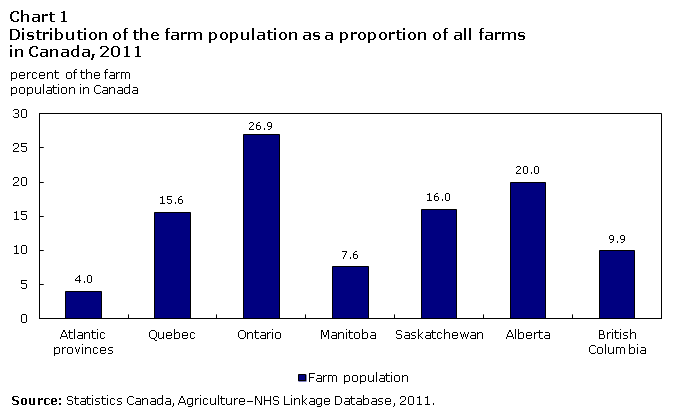
Approximately 45.0% of the farm population were farm operators, while the other 55.0% were other members of their households.
Age distribution
In general, the farm population was older than the total populationFootnote 4. Although those under 35 years old made up the largest portion (38.5%) of the farm population, the proportion in the total population (43.2%) was higher (Chart 2). Nearly a third of both the farm population and the total population were between the ages of 35 years and 54 years (29.9% and 29.7% respectively). Those aged 55 years or older made up a slightly higher percentage of the farm population (31.6%) compared to the total population (27.1%).
This broader farm population consists of farm operators and the other people in their households. Nearly half (48.2%) of farm operators were aged 55 or older in 2011, while about 1 in 12 (8.2%) were under 35 years old. Comparatively, in the self-employed labour force about one-third (33.2%) were 55 or older and about 1 in 6 (15.6%) were under 35.
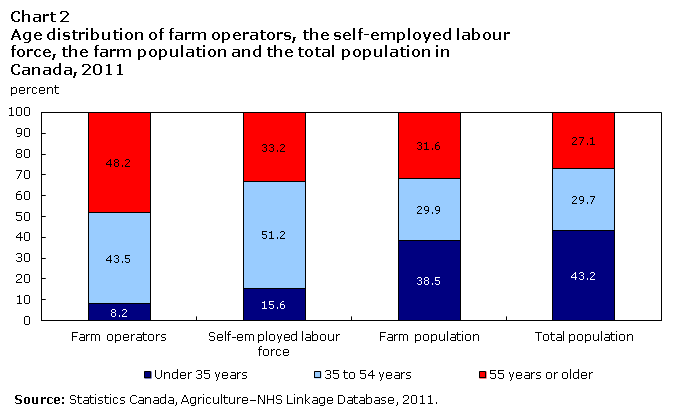
The farm populations in British Columbia and the Atlantic provinces had the largest proportion of individuals aged 55 years or older (35.7% and 36.0% respectively). The farm populations in Quebec and Ontario, in turn, were largely comprised of younger individuals, with 42.3% of the farm population in Quebec and 40.8% of the farm population in Ontario under the age of 35 years.
Approximately 1 in 10 (9.6%) of those aged under 35 in the farm population was a farm operator, with the remaining 90.4% comprising other members of the household (Chart 3). Conversely, the majority of the farm population aged 35 years or older were farm operators (67.1%).
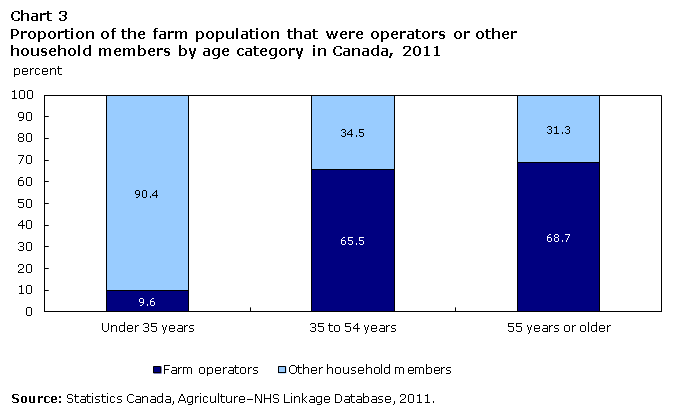
Mother tongue
The most common mother tongue in the Canadian farm population was English (72.3%), followed by French (17.0%), German (4.7%) and Dutch (1.8%) (Table 2).
In the total population, English and French were the most frequently reported mother tongues (57.4% and 21.3% respectively), followed by Panjabi (Punjabi) (1.3%) and Chinese (1.2%).
Mother tongue is defined as the first language a person learned at home in childhood and still understood at the time of the 2011 NHS.
Within the farm population, English was the predominant mother tongue for every province except Quebec, where French was the dominant language, followed by English. In British Columbia, Punjabi was the second most common mother tongue, spoken by 8.8% of the farm population. In the other provinces, the second most common mother tongues were either German or French.
This table displays the results of table 2 mother tongues in the farm population in canada. The information is grouped by rank (appearing as row headers), mother tongue, farm population and percentage, calculated using all languages, 650,395 , 100.0, all others (including multiple responses), 12,205 and 1.9 units of measure (appearing as column headers).
| Rank | Mother tongue | Farm population | Percentage |
|---|---|---|---|
| All languages | 650,395 | 100.0 | |
| 1 | English | 470,410 | 72.3 |
| 2 | French | 110,260 | 17.0 |
| 3 | German | 30,800 | 4.7 |
| 4 | Dutch | 11,970 | 1.8 |
| 5 | Panjabi (Punjabi) | 5,770 | 0.9 |
| 6 | Ukrainian | 5,045 | 0.8 |
| 7 | Italian | 1,310 | 0.2 |
| 8 | Polish | 1,140 | 0.2 |
| 9 | Hungarian | 835 | 0.1 |
| 10 | Portuguese | 650 | 0.1 |
| All others (including multiple responses) | 12,205 | 1.9 | |
| Source: Statistics Canada, Agriculture–NHS Linkage Database, 2011. | |||
Residence
Of the 650,395 people in the farm population, the majority (90.0%) reported living in rural areas, while the remaining 10.0% lived in population centres.
In sharp contrast, the majority (81.2%) of the total population of Canada lived in population centres, while the remaining 18.8% lived in rural areas. Close to 1 in 10 (9.5%) of this rural population was part of the farm population.
Rural areas are classified as all areas outside population centres. Population centres refer to areas with a population of at least 1,000 and a population density of 400 persons or more per square kilometre, based on the current census population count. Population centres are further classified as small population centres with a population between 1,000 and 29,999, medium population centres with a population between 30,000 and 99,999, and large urban population centres with a population of 100,000 or more.
Compared to the other provinces, Ontario (93.4%), Manitoba (92.9%) and Alberta (92.1%) had the largest proportions of the farm population living in rural areas. In contrast, British Columbia had the smallest proportion of the farm population living in rural areas (77.1%).
Among the total population, the largest proportions living in rural areas were in the Atlantic provinces (44.9%) and Saskatchewan (32.8%). Similar to the farm population, British Columbia had the smallest proportion of its total population living in rural areas (13.9%).
In total, the rural farm population represented 9.5% of the total rural population in Canada (Table 3). This proportion varied across the country, with the largest proportion in Saskatchewan (27.8%) and the smallest in the Atlantic provinces (2.4%).
This table displays the results of table 3 rural farm population as a percentage of the total rural population in canada rural farm population, total rural population and rural farm population as a percentage of total rural population (appearing as column headers).
| Rural farm population | Total rural population | Rural farm population as a percentage of total rural population | |
|---|---|---|---|
| Canada | 585,180 | 6,151,880 | 9.5 |
| Atlantic provinces | 24,155 | 1,027,600 | 2.4 |
| Quebec | 90,735 | 1,511,525 | 6.0 |
| Ontario | 163,435 | 1,775,670 | 9.2 |
| Manitoba | 45,660 | 317,310 | 14.4 |
| Saskatchewan | 91,785 | 330,540 | 27.8 |
| Alberta | 119,570 | 588,915 | 20.3 |
| British Columbia | 49,840 | 600,305 | 8.3 |
| Source: Statistics Canada, Agriculture–NHS Linkage Database, 2011 and the National Household Survey, 2011. | |||
Among the farm population living in population centres, most lived in small population centres (43.4%), followed closely by large population centres (42.3%). In comparison, among the total population living in population centres, most lived in large population centres (74.3%), followed by small population centres (15.0%).
In total, 22.9% of the farm population in British Columbia lived in population centres, the largest proportion among the provinces, followed by 11.6% in Saskatchewan and 10.8% in Quebec. Among the farm population in British Columbia living in population centres, the majority lived in large population centres (67.4%). Conversely, in Saskatchewan the largest proportion lived in small population centres (62.4%).
Average household size
In 2011, the average household size in the farm population was 2.9 persons. This compares to an average of 2.5 persons in private households in the total population.
The average farm household size ranges across the country from a high of 3.1 in Ontario to a low of 2.7 in Saskatchewan. In the total population, the average household size ranges from a high of 2.6 in Ontario and Alberta to a low of 2.3 in Quebec.
Larger households were more common in the rural farm population than in the total rural population. The proportion of four-person households, five-person households and six-or-more-person households was larger in the rural farm population than in the total rural population (Chart 4). The proportion of one-person households in the rural farm population was smaller than in the total rural population.
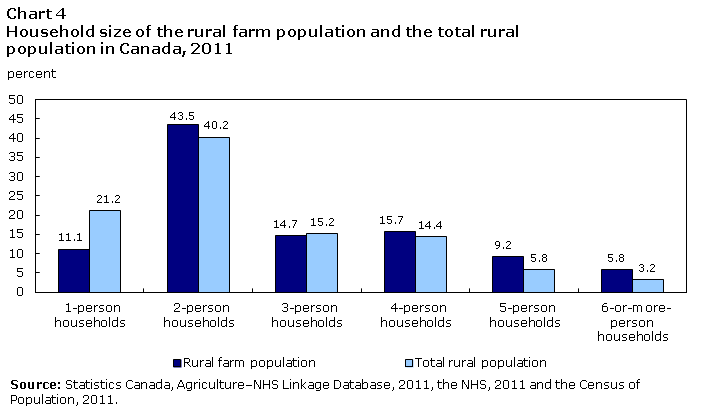
Religious affiliation
In 2011, 82.6% of the farm population reported a religious affiliation. This was higher than the total population, in which 76.1% reported a religion affiliation.
Of those reporting a religious affiliation in the farm population, the most frequently reported religions were Roman Catholic, the United Church and Lutheran. For the total population reporting a religion affiliation, the most frequently reported were Roman Catholic, the United Church and Anglican. Some groups, like the Mennonites, were more present in the farm population than in the total population (Table 4).
This table displays the results of farm population 2011 farm population 2011, total population 2011 and number of persons, calculated using number of persons and percentage units of measure (appearing as column headers).
| Farm population 2011 | Total population 2011 | |||
|---|---|---|---|---|
| Number of persons | Percentage | Number of persons | Percentage | |
| All persons that reported religious affiliations | 537,320 | 100 | 24,929,085 | 100 |
| Roman Catholic | 206,905 | 38.5 | 12,699,430 | 50.9 |
| United Church | 100,830 | 18.8 | 2,004,845 | 8 |
| Lutheran | 30,085 | 5.6 | 477,405 | 1.9 |
| Christian Footnote 5 | 29,470 | 5.5 | 1,470,310 | 5.9 |
| Anglican | 29,065 | 5.4 | 1,608,990 | 6.5 |
| Mennonite | 28,270 | 5.3 | 175,780 | 0.7 |
| Baptist | 17,220 | 3.2 | 634,450 | 2.5 |
| Presbyterian | 16,080 | 3 | 472,065 | 1.9 |
| ProtestantFootnote 6 | 13,015 | 2.4 | 549,190 | 2.2 |
| Christian Reformed Church | 8,255 | 1.5 | 65,395 | 0.3 |
| All other religions | 58,100 | 10.8 | 4,771,270 | 19.1 |
Footnotes
|
||||
For the farm population reporting a religious affiliation, Roman Catholic was the most frequently reported religion for each province except for Manitoba where it was the United Church. For the total population reporting a religious affiliation, Roman Catholic was the most frequently reported in every province.
In 2011, 17.4% of the farm population in Canada, accounting for 113,075 persons, reported no religious affiliation, compared to 23.9% of the total population, or 7,817,420 persons.
Among the provinces, the farm populations of British Columbia and Alberta most frequently reported no religious affiliation (37.4% and 23.4% respectively). The same trend was apparent in the total population, where these same provinces most frequently reported no religious affiliation (44.1% and 31.6%).
Income of Canadian farm families
The median total income for economic families in the farm population was $74,604 in 2010. In comparison, the median total income for economic families in the total population was $76,458. The 197,045 farm families represent 2.1% of the economic families in Canada. Economic families do not include one-person households, which represented 26,205 households or 11.6% of all farm households in 2011.
Farm economic family or farm family refer to an economic family where at least one person is a farm operator. The two terms are used interchangeably in this report. Economic family refers to a group of two or more persons who live in the same dwelling and are related to each other by blood, marriage, common-law, adoption or a foster relationship.
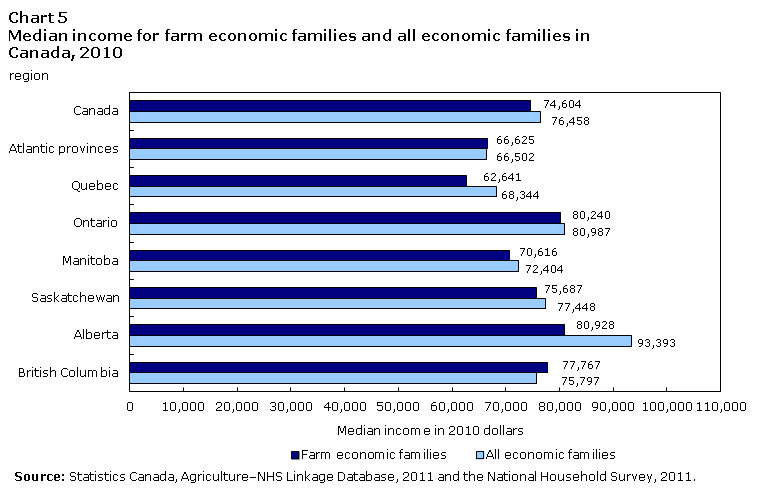
The median total income for farm economic families varied across the provinces, ranging from $62,641 in Quebec to $80,928 in Alberta (Chart 5). In the total population, the median income for all economic families ranged from $66,502 in the Atlantic provinces to $93,393 in Alberta. In most provinces, the median income for farm families was lower than for economic families in the total population.
The median income of farm economic families in rural areas was $72,700, compared to a median income of $93,590 for those in population centres. The median income for farm families in rural areas was lower than for families in population centres in each province.
In rural areas, the median income of farm families was $72,700 compared to $71,422 for all economic families in Canada. In all provinces except for Quebec, Ontario and Alberta, the median income for rural farm families was higher than for all rural economic families (Chart 6).
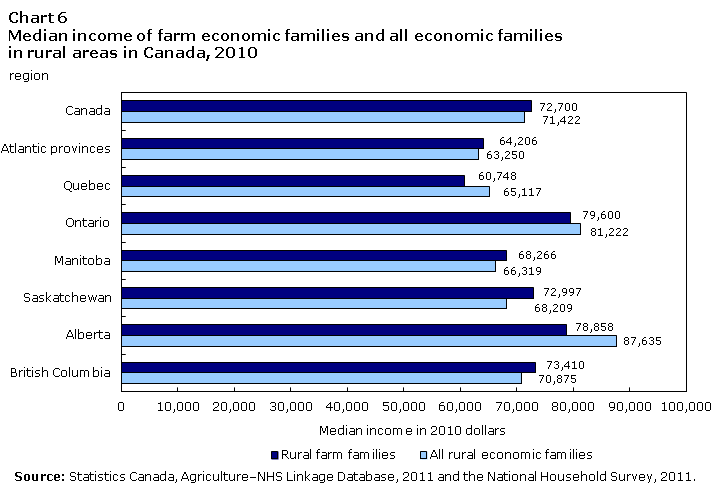
Median income by farm type
Poultry and egg production represented 2.1% of farm families in 2011 and had the highest median income in 2010 compared to other types of farming, at $90,250 (Table 5). The second highest median income, at $82,473, was for the 3.9% of farm families in "greenhouse, nursery and floriculture production". Nearly one-third (29.7%) of farm families were involved in the most common type of farming, "oilseed and grain farming", which had the third highest median income ($80,865). Families involved in "dairy cattle and milk production" represented 7.9% of farm families and had the lowest median income of $65,010. This may be due to a number of factors, including that the "dairy cattle and milk production" farm type also had the lowest percentage of operators working off the farm in 2011.
Farm types are based on the North American Industrial Classification System (NAICS) provides a framework for classifying farms based on the commodities produced and the commodity value.
This table displays the results of table 5 median income of farm economic families by naics farm type in canada. The information is grouped by type of farming (by naics) (appearing as row headers), median total income for farm families (2010 dollars) and percent of farm families (appearing as column headers).
| Type of farming (by NAICS) | Median total Income for farm families (2010 dollars) | Percent of farm families |
|---|---|---|
| All types of farming | 74,604 | 100.0 |
| Poultry and egg production | 90,250 | 2.1 |
| Greenhouse, nursery and floriculture production | 82,473 | 3.9 |
| Oilseed and grain farming | 80,865 | 29.7 |
| Fruit and tree nut farming | 80,505 | 4.1 |
| Other animal production | 77,587 | 11.3 |
| Vegetable and melon farming | 76,608 | 2.6 |
| Other crop farming | 71,544 | 17.3 |
| Hog and pig farming | 68,594 | 1.7 |
| Sheep and goat farming | 67,612 | 1.9 |
| Beef cattle ranching & farming including feedlots | 66,873 | 17.6 |
| Dairy cattle and milk production | 65,010 | 7.9 |
| Source: Statistics Canada, Agriculture–NHS Linkage Database, 2011. | ||
A closer look at operators of Canadian farms
Of the 292,795 farm operators in the Ag-NHS database, there were 212,185 (72.5%) male operators and 80,605 (27.5%) female operators in Canada's provinces (Table 6). Similarly, in the total population, the majority of the self-employed labour force was male in 2011 (64.0% male and 36.0% female) according to the 2011 NHS.
Compared with the other provinces, British Columbia had the largest proportion of female farm operators (36.5%), followed by Alberta (29.2%) and Ontario (28.4%).
Farm operators refer to persons involved in the day to day management decisions of a census farm that were aged 15 years or older. Up to three farm operators could be reported per farm.
The self-employed labour force refers to persons that were in the labour force and self-employed with or without a business as well as unpaid family workers that were 15 years or older at the time of the 2011 National Household Survey.
This table displays the results of table 6 proportion of farm operators and the total self-employed labour force by gender in canada farm operators (%) and self-employed labour force (%), calculated using male, female and total units of measure (appearing as column headers).
| Farm operators (%) | Self-employed labour force (%) | |||||
|---|---|---|---|---|---|---|
| Male | Female | Total | Male | Female | Total | |
| Canada | 72.5 | 27.5 | 100 | 64 | 36 | 100 |
| Atlantic provinces | 77.4 | 22.6 | 100 | 64.2 | 35.8 | 100 |
| Quebec | 74.1 | 25.9 | 100 | 63.4 | 36.6 | 100 |
| Ontario | 71.6 | 28.4 | 100 | 64.3 | 35.7 | 100 |
| Manitoba | 76.1 | 23.9 | 100 | 67.3 | 32.7 | 100 |
| Saskatchewan | 77 | 23 | 100 | 66.7 | 33.3 | 100 |
| Alberta | 70.8 | 29.2 | 100 | 64.2 | 35.8 | 100 |
| British Columbia | 63.5 | 36.5 | 100 | 62.7 | 37.3 | 100 |
| Source: Statistics Canada, Agriculture–NHS Linkage Database, 2011 and the National Household Survey, 2011. | ||||||
Age distribution of farm operators
In general, farm operators were older than the total self-employed labour force. Nearly half of farm operators were 55 years or older (48.2%) in 2011. In comparison, 1 in 3 people in the total self-employed labour force was aged 55 years or older (33.2%), according to the 2011 NHS.
British Columbia also had the largest proportion of farm operators aged 55 years or older among the provinces. In comparison, Saskatchewan had the largest proportion of the total self-employed labour force aged 55 years or older. Among the provinces, Quebec had the smallest proportion of farm operators aged 55 years or older. This was also the case for the total self-employed labour force, where Quebec also had the smallest proportion (Table 7).
This table displays the results of table 7 proportion of farm operators and the total self-employed labour force by age category in canada farm operators (%) and self-employed labour force (%), calculated using under 35 years, 35 to 54 years, 55 years or older and all ages units of measure (appearing as column headers).
| Farm operators (%) | Self-employed labour force (%) | |||||||
|---|---|---|---|---|---|---|---|---|
| Under 35 years | 35 to 54 years | 55 years or older | All ages | Under 35 years | 35 to 54 years | 55 years or older | All ages | |
| Canada | 8.2 | 43.5 | 48.2 | 100 | 15.6 | 51.2 | 33.2 | 100 |
| Atlantic provinces | 6.1 | 41 | 52.9 | 100 | 13.1 | 51 | 35.9 | 100 |
| Quebec | 10.9 | 49.4 | 39.7 | 100 | 16.9 | 53.4 | 29.7 | 100 |
| Ontario | 8.2 | 42.5 | 49.3 | 100 | 15.2 | 51.9 | 33 | 100 |
| Manitoba | 8.8 | 45.9 | 45.3 | 100 | 14.8 | 46.9 | 38.3 | 100 |
| Saskatchewan | 8.9 | 41.8 | 49.3 | 100 | 15.9 | 41.5 | 42.6 | 100 |
| Alberta | 7.4 | 43.1 | 49.6 | 100 | 17 | 49.4 | 33.6 | 100 |
| British Columbia | 5.4 | 40.5 | 54.1 | 100 | 14.7 | 51.6 | 33.7 | 100 |
| Source: Statistics Canada, Agriculture–NHS Linkage Database, 2011 and the National Household Survey, 2011. | ||||||||
Female farm operators were proportionally older than females in the total self-employed labour force. Nationally, there were 45.3% of female farm operators 55 years or older, compared to 29.1% of females in the total self-employed labour force. Male farm operators were also older than males in the total self-employed labour force, with 49.4% of male operators aged 55 years or older, compared to 35.5% of males in the total self-employed labour force.
Median age of farm operators
According to the 2011 Ag-NHS, the median age of farm operators was 54. The median age of the total self-employed labour force was 49.
The median age of male farm operators was 54, while the median age of female operators was 53. In the total self-employed labour force, the median age of males (50 years) was older than the median age for females (48 years).The median age is the point where exactly one half of the population is older and the other half is younger.
Among the provinces, the lowest median age for farm operators was 52 years in Quebec. In British Columbia, the median age of operators was 56 years—the highest of the provinces.
In each of the provinces, the median age of female operators was lower than for male operators except in Saskatchewan where the median age for female and male operators was the same.
Operators on multi-generational farms
One in seven operators was on a multi-generational farm (14.4%). Among the provinces, Quebec had the largest proportion of operators on multi-generational farms (20.3%), while Alberta had the lowest proportion (12.3%).
A multi-generational farm includes at least two operators with an age difference of 20 years or more.
Highest level of education
In 2011, the majority of farm operators had completed at least a secondary school education (78.3%). The remaining 21.7% of farm operators and 12.5% of the total self-employed labour force reported no certificate, diploma or degree in the 2011 NHS.
A larger proportion of farm operators than of the total self-employed labour force reported their highest level of education attainment as a secondary school certificate, trades certificate, or college diploma (Chart 7). In contrast, approximately 1 in 6 farm operators reported university credentials as their highest level of education attainment, compared to one-third of the total self-employed labour force.
Among the farm operators, the proportion that attained a secondary school education or higher was larger for female operators (86.3%) than for male operators (75.3%). A trades certificate (including apprenticeship) was the highest education attainment for 17.4% of male operators and 9.3% of female operators. Over a quarter, 26.4%, of all the female operators reported a college diploma as their highest level of education compared to 16.6% of male operators. At 23.2%, the proportion of female operators with university credentials was larger than the 15.0% of male operators with university credentials.
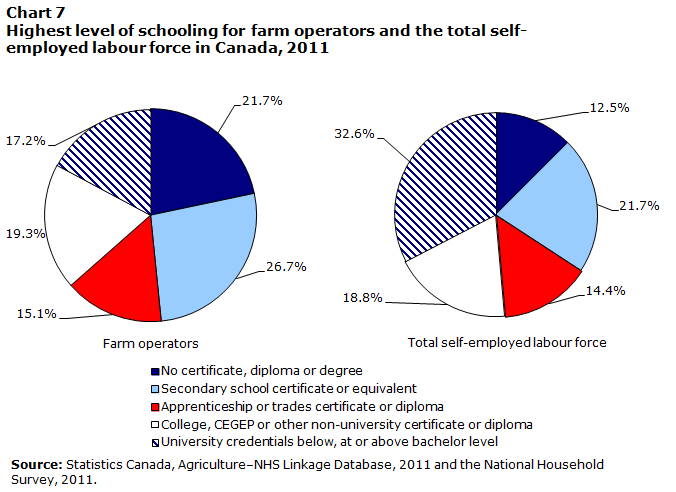
Major field of study
In 2011, over half of farm operators reported a post-secondary education (51.6%), while 65.8% of the total self-employed labour force attained a post-secondary education. Over half of female farm operators, 58.8%, and nearly half of male operators, 48.9%, attained a post-secondary education.
For male operators with a post-secondary education, "agriculture" was the most frequently reported field of study (28.3%), followed by "mechanic and repair technologies/technicians" (15.5%), and "construction trades" (8.6%). For males with a post-secondary education in the total self-employed labour force, "business, management, marketing and related support services" (16.9%) and "construction trades" (9.3%) were the most frequently reported major fields of study.
The most frequently reported fields of study for female operators with a post-secondary education were "health professions and related programs" (23.6%), "business, management, marketing and related support services" (22.7%), and "education" (13.5%), followed by "agriculture" (9.9%). In comparison, the two most frequently reported fields of study for females in the total self-employed labour force were "business, management, marketing and related support services" (20.7%) and "health professions and related programs" (18.5%).
Main occupation
The most frequently reported main occupations by farm operators were "management occupations", "trades, transport and equipment operators and related occupations" and "natural resources, agriculture and related production occupations". In comparison, in the total self-employed labour force, the most frequently reported main occupations were "management occupations", "trades, transport and equipment operators and related occupations" and "sales and service occupations" (Table 8).
Occupation refers to the kind of work persons were doing during the week of Sunday, May 1 to Saturday, May 7, 2011, as determined by their kind of work and the description of the main activities in their job.
The occupational data of the 2011 National Household Survey are produced using the National Occupational Classification (NOC) 2011.
Occupations related to agricultural were classified as "management occupations" or "natural resources, agriculture and related production occupations".
This table displays the results of table 8 the five most frequently reported main occupations by farm operators and the total self-employed labour force in canada farm operators and total self-employed labour force (appearing as column headers).
| Farm operators | Total self-employed labour force | |
|---|---|---|
| All | 100 | 100 |
| Management occupations | 50.7 | 24.3 |
| Trades, transport and equipment operators and related occupations | 12.2 | 17.4 |
| Natural resources, agriculture and related production occupations | 10.2 | 3.8 |
| Business, finance and administration occupations | 7.6 | 11.6 |
| Sales and service occupations | 6.3 | 13.8 |
| Other occupations | 12.9 | 29.1 |
| Source: Statistics Canada, Agriculture–NHS Linkage Database, 2011 and the National Household Survey, 2011. | ||
The occupations most frequently reported by male and female farm operators differed. Female operators most frequently reported "management occupations" (35.5%), "business, finance and administration occupations" (20.6%), and "sales and service occupations" (11.5%). Male operators, most frequently reported "management occupations" (56.5%), "trades, transport and equipment operators and related occupations" (16.0%), and "natural resources, agriculture and related production occupations" (10.5%).
In the total self-employed labour force, "management occupations" were the most frequently reported main occupation for males (27.8%), while for females, "sales and service occupations" (20.8%) were the most frequently reported.
Feature: Immigrant farming population: A closer look at immigrant farmers who made Canada their home
How many immigrants were among the farm population?
There were 44,790 immigrants in the farm population in Canada, making up 6.9% of the total farm population. Immigrants made up a smaller proportion of the farm population than of the total population, with immigrants representing 20.7% of the total population in Canada.
Although the majority of the farm population in each province was non-immigrant, the proportion of immigrants in the farm population ranged from a high of 19.8% in British Columbia to a low of 2.1% in Saskatchewan.
An immigrant refers to a person who is or has ever been a landed immigrant or a permanent resident (who landed in Canada prior to May 10, 2011).
Non-immigrant refers to a person who was not an immigrant. For this article, this includes those that were Canadian born as well as non-permanent residents.
Ontario had the highest number of immigrants among the provinces, followed by British Columbia (Table 9). Proportionally, however, there were more immigrants in the farm population in British Columbia (19.8%) than in Ontario (8.6%). In the total population, Ontario had the highest number and largest proportion of immigrants, while British Columbia was second in both number and proportion.
This table displays the results of table 9 proportion of immigrants in the farm population and in the total population in canada immigrants in the farm population and immigrants in the total population, calculated using number, percentage of farm population and percentage of total population units of measure (appearing as column headers).
| Immigrants in the farm population | Immigrants in the total population | |||
|---|---|---|---|---|
| Number | Percentage of farm population | Number | Percentage of total population | |
| Canada | 44,790 | 6.9 | 6,768,515 | 20.7 |
| Atlantic provinces | 1,345 | 5.1 | 92,990 | 4.1 |
| Quebec | 2,700 | 2.7 | 974,895 | 12.6 |
| Ontario | 14,995 | 8.6 | 3,611,365 | 28.5 |
| Manitoba | 3,145 | 6.4 | 184,500 | 15.7 |
| Saskatchewan | 2,170 | 2.1 | 68,775 | 6.8 |
| Alberta | 7,645 | 5.9 | 644,115 | 18.1 |
| British Columbia | 12,775 | 19.8 | 1,191,875 | 27.6 |
| Source: Statistics Canada, Agriculture–NHS Linkage Database, 2011 and the National Household Survey, 2011. | ||||
Where were Canada's immigrant farm population born?
The five most frequently reported places of birth for Canada's immigrant farm population were the Netherlands, the United Kingdom, the United States, Germany and India (Table 10). In the total population, the most frequently reported places of birth for immigrants born outside of Canada were India, China, the United Kingdom, and the Philippines.
The most frequently reported place of birth for the immigrant farm population differed among the provinces. The Netherlands was the leading place of birth in Ontario and Alberta, while the United Kingdom was the leading place of birth in Manitoba and Saskatchewan. In the Atlantic provinces, the United States was the leading place of birth for the immigrant farm population. In Quebec, Switzerland and France were the most frequently reported places of birth for the immigrant farm population, while India was the most common place of birth for the immigrant farm population in British Columbia.
This table displays the results of table 10 places of birth for immigrants in the farm population and total population in canada. The information is grouped by rank (appearing as row headers), place of birth, farm population, total population and number of immigrants, calculated using number of immigrants, percentage, all, 44,790 , 6,766,320, all others, 10,215 , 22.8, 4,259,710 and 63.0 units of measure (appearing as column headers).
| Rank | Place of birth | Farm population | Total population | ||
|---|---|---|---|---|---|
| Number of immigrants Footnote 7 | Percentage | Number of immigrants Footnote 8 | Percentage | ||
| All | 44,790 | 6,766,320 | |||
| 1 | Netherlands | 8,695 | 19.4 | 98,355 | 1.5 |
| 2 | United Kingdom | 6,645 | 14.8 | 536,060 | 7.9 |
| 3 | United States | 5,750 | 12.8 | 262,695 | 3.9 |
| 4 | Germany | 3,820 | 8.5 | 151,810 | 2.2 |
| 5 | India | 3,785 | 8.5 | 547,695 | 8.1 |
| 6 | Switzerland | 2,400 | 5.4 | 18,645 | 0.3 |
| 7 | Italy | 945 | 2.1 | 256,775 | 3.8 |
| 8 | China Footnote 9 | 890 | 2 | 545,245 | 8.1 |
| 9 | Mexico | 880 | 2 | 69,645 | 1 |
| 10 | Belgium | 750 | 1.7 | 19,685 | 0.3 |
| All others | 10,215 | 22.8 | 4,259,710 | 63 | |
Footnotes
|
|||||
When did the immigrant farm population immigrate to Canada?
Over one-third (34.4%) of the immigrant farm population immigrated prior to 1971. This compares to 18.6% of the immigrants in the total population (Chart 8).
Recent immigrants, those that immigrated between 2001 and 2011, made up 14.6% of the immigrant farm population. In comparison, recent immigrants made up 31.8% of the immigrants in the total population.
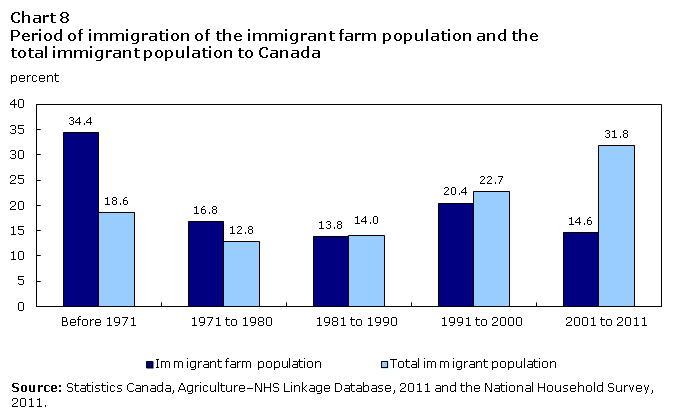
The place of birth of immigrants differs by immigration period. The most frequently reported places of birth for immigrants in the farm population that immigrated prior to 1971 were the Netherlands (22.0%), the United Kingdom (19.5%) and Germany (12.0%). For immigrants in the total population that immigrated prior to 1971, the most frequently reported places of birth were the United Kingdom (22.2%), Italy (17.0%) and Germany (7.7%).
For recent immigrants in the farm population, the Netherland (20.7%), the United Kingdom (17.0%) and the United States (14.2%) were the most frequently reported places of birth, while in the total population, China (12.4%), India (11.3%) and the Philippines (10.5%) were the most common places of birth for recent immigrants.
What was the age distribution of the immigrant farm population?
The immigrant farm population was older than the non-immigrant farm population. Over half of the immigrant farm population was 55 years or older (51.3%) compared to one-third (30.2%) of the non-immigrant farm population. The proportion of the farm population aged 65 years or older was also higher for immigrants than non-immigrants (28.0% compared to 13.2%).
This is similar to the story in the total population where the immigrant population was also older than those that were not immigrants. The proportion of the total population aged 55 years or older was 36.1% for immigrants and 24.8% for those that were not immigrants.
What were the mother tongues of the immigrant farm population?
The most common mother tongues for Canada's immigrant farm population were English (34.5%), Dutch (17.8%), German (16.7%), Punjabi (8.0%) and French (3.8%). In the total population, the most frequently reported mother tongues for immigrants were English (23.0%), Chinese (4.8%), Tagalog (4.7%) and Spanish (4.5%).
In all of the provinces, the most common mother tongue for the immigrant farm population was English except for Quebec where French was the most common mother tongue. The second most common mother tongue for the immigrant farm population in Quebec, Manitoba and Saskatchewan was German. Dutch was the second most common mother tongue for the immigrant farm population in the Atlantic provinces, Ontario and Alberta, while Punjabi was the second most common mother tongue in British Columbia.
Where does the immigrant farm population live?
Of the 44,790 people in the immigrant farm population, 83.5% lived in rural areas; this can be compared to the non-immigrant farm population of 605,605 people, of which 90.5% lived in rural areas. In the total population, 5.5% of immigrants and 22.2% of those who were not immigrants lived in rural areas.
In most provinces, the immigrant farm population was less likely to live in rural areas than the non-immigrant farm population. This was most apparent in British Columbia and Ontario. In the British Columbia farm population, 67.9% of immigrants lived in rural areas compared to 79.4% of non-immigrants. In Ontario, 88.7% of the immigrant farm population lived in rural areas, compared to 93.9% of the non-immigrant farm population. Manitoba was the exception as the proportion of the immigrant farm population in the province that lived in rural areas was actually higher than the proportion of the non-immigrant farm population (94.0% compared to 92.8%).
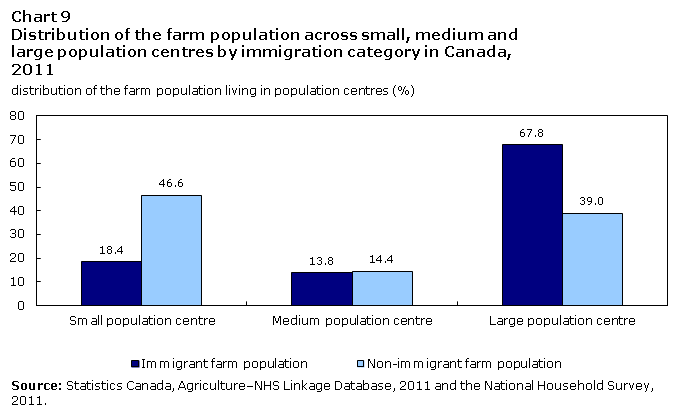
For the farm population living in population centres, immigrants were more likely than non-immigrants to live in large population centres (67.8% compared to 39.0%) (Chart 9). Similarly, among the total population living in population centres, a higher proportion of immigrants (91.6%) than those who were not immigrants (68.8%) resided in large population centres.
What were the religious affiliations of the immigrant farm population?
In the farm population, immigrants were less likely to report a religious affiliation than non-immigrants (80.9% and 82.7%, respectively). In contrast, immigrants in the total population were more likely to report a religious affiliation than those that were not immigrants (79.9% and 75.1% respectively).
Of the immigrant farm population reporting a religious affiliation, the most frequently reported religions were Roman Catholic (30.4%), Sikh (9.9%), and Christian (7.2%). In the total population, the most frequently reported religions by immigrants were Roman Catholic (35.2%), Muslim (13.3%) and Christian (7.7%).
For the non-immigrant farm population that reported a religious affiliation, Roman Catholic (39.1%) was still the most frequently reported, followed by the United Church (19.7%) and Lutheran (5.6%).
Roman Catholic was the most frequently reported religious affiliation for the immigrant farm population in each province except for British Columbia where Sikh was the most frequently reported religion.
Focus on immigrant farm operators
In 2011, 9.0% (26,300) of Canada's farm operators were immigrants. This compares to 25.7% of the total self-employed labour force in Canada that were immigrants.
The proportion of farm operators that were immigrants ranged from a high of 24.4% in British Columbia to a low of 2.2% in Saskatchewan. In the total self-employed labour force, the proportion of immigrants ranged from a high of 35.7% in Ontario to a low of 5.8% in Saskatchewan.
What was the median age of immigrant farm operators?
Immigrant operators were on average older than non-immigrant operators. The median age of immigrant operators was 58 years compared to 54 years for non-immigrant operators. Similar to the farm operator population, the median age of immigrants in the total self-employed labour force was higher than non-immigrants (50 years and 49 years, respectively).
What was the highest level of education for immigrant farm operators?
The proportion of immigrant farm operators that reported having a certificate, diploma or degree was higher than that for non-immigrants (81.4% and 78.0%, respectively). The proportion of operators with a postsecondary education was also higher for immigrant operators (61.3%) than for non-immigrants (50.7%). Similarly, the proportion of immigrant farm operators that reported having a college diploma or university credentials was also higher than the proportion for non-immigrants (46.5% and 35.5% respectively).
What were the major fields of study for immigrant operators with a post-secondary education?
Immigrant farm operators with a postsecondary education were more likely to have reported "agriculture" as their field of study than non-immigrant farm operators. Of the immigrant farm operators with a postsecondary education, 25.8% reported "agriculture" as their field of study compared to 22.2% of non-immigrant operators with a postsecondary education.
What were the most common types of farming for immigrant operators?
"Oilseed and grain farming" was the most common type of farming among immigrant operators (15.8%). This compares to nearly one-third of non-immigrant operators (29.4%). The other most frequent types of farming among immigrant operators were "other animal production" (15.4%), "other crop farming" (13.7%), "fruit and tree nut farming" (12.3%) and "beef cattle ranching and farming" (11.6%). Among non-immigrant operators, after "oilseed and grain farming", the most frequent farm types were "beef cattle ranching and farming" (18.5%), "other crop farming" (17.7%), "other animal production" (11.8%) and "dairy cattle and milk production" (7.5%).
The proportion of operators that were immigrants varies greatly by farm type. In 2011, 1 in 4 operators (26.5%) of "fruit and tree nut" farms was an immigrant. Immigrant operators also made up 17.9% of all operators in "greenhouse, nursery and floriculture production". 1 in 6 operators (16.2%) in "sheep and goat farming" was an immigrant, and among operators in "vegetable and melon farming", 15.9% were immigrants. The proportion of immigrant operators was lowest in "oilseed and grain farming" (5.0%) and in "beef cattle ranching and farming" (5.8%).
Feature: Profile of operators under 35 years: A closer look at the younger generation of farm operators
How many operators were under 35 years of age?
There were 24,055 farm operators under the age of 35 years, accounting for 1 in 12 (8.2%) of all operators in the 2011 Ag-NHS database. In comparison, 1 in 6 in the total self-employed labour force was under the age of 35 years (15.6%).
Among the provinces, Quebec had the largest proportion of younger operators, while British Columbia had the smallest proportion of younger operators (Chart 10).
Among the total self-employed labour force, Alberta and Quebec had the highest proportions of those aged 15 years to 34 years, while the lowest proportion was in the Atlantic provinces.
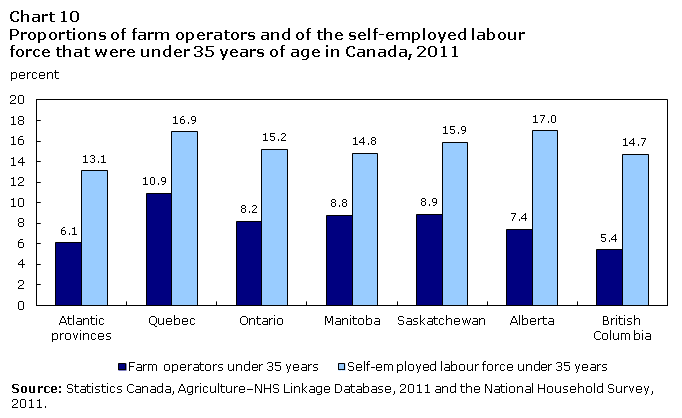
The majority of operators under 35 years were male (73.5%), consistent with the proportion of males in the total operator population (72.5%). In the total self-employed labour force, males also made up the majority of those under 35 years at 59.4%.
What was the highest level of education for younger operators?
Operators under the age of 35 years were more likely to have attained at least a secondary school education than operators aged 35 and older. For operators under the age of 35 years, 85.9% reported having a secondary school education or higher compared with 77.6% of operators aged 35 years or older.
Quebec and British Columbia had the largest proportions of operators under the age of 35 that attained at least a secondary school education (91.4% of operators in Quebec and 90.9% of operators in British Columbia).
Operators under 35 years were more likely to have completed a post-secondary education (59.5%) than operators aged 35 years or older (50.9%). Quebec had the largest proportion of operators under the age of 35 years that reported an education attainment beyond secondary school (78.8%). In Quebec, operators under the age of 35 years most frequently reported a college diploma (37.7%) or a trades certificate (29.9%) as their highest level of education attainment.
What were the major fields of study for operators under 35 years with a post-secondary education?
Of all operators that completed a post-secondary education, proportionally more operators under 35 years reported their major field of study as "agriculture" than operators 35 years or over (41.8% and 20.5% respectively). This was also true for immigrant operators that had a post-secondary education. In total, 47.2% of immigrant operators under 35 years reported "agriculture" as their major field of study, compared to 25.0% of immigrant operators aged 35 years and older.
What were the main occupations of operators under 35 years?
Nearly half of farm operators under 35 reported their main occupation as "management occupations", while in the total self-employed labour force, "trades, transport and equipment operators and related occupations" was the most frequently reported by those under 35 years (Table 11).
This table displays the results of table 11 main occupation reported by farm operators under 35 years and those under 35 years in the self-employed labour force in canada percent of operators under 35 years and percent of the self-employed labour force under 35 years (appearing as column headers).
| Percent of operators under 35 years | Percent of the self-employed labour force under 35 years | |
|---|---|---|
| All | 100 | 100 |
| Management occupations | 44.7 | 17 |
| Trades, transport and equipment operators and related occupations | 14.2 | 19.4 |
| Natural resources, agriculture and related production occupations | 13.3 | 5.7 |
| Sales and service occupations | 7 | 14.3 |
| Business, finance and administration occupations | 6.9 | 7.9 |
| Other occupations | 13.8 | 35.7 |
| Source: Statistics Canada, Agriculture–NHS Linkage Database, 2011 and the National Household Survey, 2011. | ||
How many operators under 35 years were on multi-generation farms?
In 2011, 34.5% of operators under 35 years were on multi-generational farms, compared to 12.6% of operators 35 years or older.
For operators under 35 years, Quebec and British Columbia had the largest proportions on multi-generational farms at 48.4% and 45.7% respectively. Saskatchewan had the smallest proportion of operators under 35 years on multi-generational farms at 25.9%.
The 2011 Census of Agriculture and the National Household Survey Linkage data are available without charge in CANSIM: tables 004-0100 to 004-0129.
For more information about farms in Canada, consult the CEAG 2011 release at: /eng/ca2011/index
For custom data requests from the Ag-NHS linkage please contact STATCAN.infostats-infostats.STATCAN@canada.ca
Notes
Footnotes
- Footnote 1
-
Refers to a farm, ranch or other agricultural operation that produces at least one of the following products intended for sale: crops, livestock, poultry, animal products, greenhouse or nursery products, Christmas trees, mushrooms, sod, honey or bees, and maple syrup products.
- Footnote 2
-
Dwelling used for commercial, institutional or communal purposes, such as a hotel, a hospital or a work camp.
- Footnote 3
-
This refers to the population of Canada's provinces, which was published in the 2011 National Household Survey.
- Footnote 4
-
The total population includes the farm population.
- Date modified: